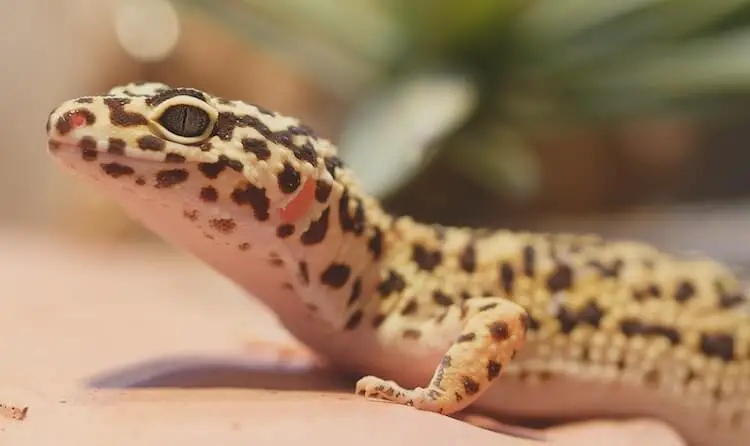Determining the ideal feeding frequency for leopard geckos requires careful consideration of several factors. As ectothermic reptiles, Leopard Gecko have much lower metabolisms and energy requirements than warm-blooded pets. Overfeeding can quickly lead to obesity and health problems. However, underfeeding can result in malnutrition. By understanding the unique dietary needs of leopard geckos and tailoring feedings accordingly, you can keep your pet healthy and thriving.
Adult Leopard Geckos

For adult leopard geckos over 1 year old, feeding 2-3 times per week is generally recommended. The specific amount at each feeding depends on the size and age of your gecko. Here are some general feeding guidelines:
- Adult geckos 6 months to 1 year old: Feed 4-5 medium-sized feeder insects 2 times per week.
- Adult geckos over 1 year old: Feed 5-7 medium-sized feeder insects 2-3 times per week.
- Obese or overweight adult geckos: Feed smaller amounts 1-2 times per week until weight normalizes.
- Underweight adult geckos: Slowly increase feeding frequency and amount until gecko reaches a healthy weight.
Adult leopard geckos have slower metabolisms and are not as active as juveniles. Overfeeding can quickly lead to obesity. Monitor your gecko’s body condition and adjust feedings if you notice significant weight changes. Providing a variety of feeder insects, including crickets, mealworms, waxworms and dubia roaches, helps ensure proper nutrition.
Juvenile Leopard Geckos
For juvenile leopard geckos under 1 year old, more frequent feedings are required to support their rapid growth:
- Hatchling geckos under 3 months old: Offer food daily, providing as much as they will eat in a 15 minute period.\n\n- Juveniles 3-6 months old: Feed daily, providing 6-8 small feeder insects per feeding.
- Juveniles 6-12 months old: Feed 3-4 times per week, providing larger amounts of 4-5 insects at each feeding.
Check that juvenile geckos are maintaining a healthy weight as they grow. Since juveniles are more active, they typically require more frequent, larger feedings than adult geckos. Their rapid growth means your leopard gecko can become underweight if insufficient food is provided.
What to Feed Leopard Geckos
In addition to following ideal feeding frequencies, it is vital to provide leopard geckos with a balanced, nutritious diet. Here are some top diet tips:
- Offer a variety of feeder insects, including crickets, dubia roaches, mealworms, and waxworms. Rotate different feeders to ensure balanced nutrition.
- Gut load feeder insects with nutritious foods like vegetables, fruits, grains and calcium powder. This passes more nutrients on to your gecko.
- Dust insects with calcium and vitamin D3 supplements at every other feeding for juveniles, and 1-2 times weekly for adults.
- Avoid overfeeding high-fat worms like waxworms, as these can cause obesity. Offer waxworms sparingly as treats.
- Provide a small dish of fresh, calcium-fortified crested gecko diet 3 times per week. This provides added nutrition.
- Ensure feeder insects are an appropriate size for your leopard gecko – no wider than the space between their eyes.
Following the right feeding schedule and providing a nutritious, balanced diet is crucial for keeping leopard geckos healthy and active. Monitor your pet’s growth, weight and appetite, and adjust feeding frequency and amounts as needed. With the proper diet, your leopard gecko can thrive.
Conclusion
Determining the ideal feeding frequency for leopard geckos requires balancing the needs of juveniles and adult geckos. While hatchlings and juveniles under 1 year need more frequent feedings to support growth and activity, mature adults over 1 year old typically only require two to three appropriately-sized feedings per week. Pay close attention to your pet’s weight, energy levels and appetite, and adjust the diet to match their needs. Aim to provide a variety of gut-loaded, dusted feeder insects at each feeding to ensure proper nutrition. Following these best practices will keep your leopard gecko healthy and allow them to thrive.
FAQs About How Often to Feed Leopard Gecko
Can you overfeed a leopard gecko?
Yes, you can overfeed a leopard gecko. Overfeeding can lead to obesity and health issues. It’s essential to follow a feeding schedule and provide appropriately sized prey items, ensuring your gecko eats about every 2-3 days for adults and more frequently for juveniles.
What types of insects should I feed my leopard gecko, and how often?
Leopard geckos primarily eat insects like crickets, mealworms, and dubia roaches. For variety, you can include waxworms and occasional treats like superworms. Feed juveniles daily and adults every 2-3 days, offering an amount they can consume in 10-15 minutes.
Do leopard gecko feeding habits change with age?
Yes, leopard gecko feeding habits change with age. Juveniles require more frequent meals (daily) to support growth. As they mature, you can reduce feeding to every 2-3 days for adults. Adjust their diet to maintain a healthy weight.
Should I adjust the feeding frequency during the breeding season?
During the breeding season, increase the feeding frequency for both male and female leopard geckos. Offer food every 2-3 days to ensure they have the energy and nutrition needed for mating and egg production. Monitor their weight and adjust as needed.
How do I know if my leopard gecko is hungry?
You can tell if your leopard gecko is hungry by observing its behavior. A hungry gecko may actively hunt, show interest in prey, or display increased alertness. Additionally, their tail should remain plump and not excessively thin, indicating they are adequately fed.
F



